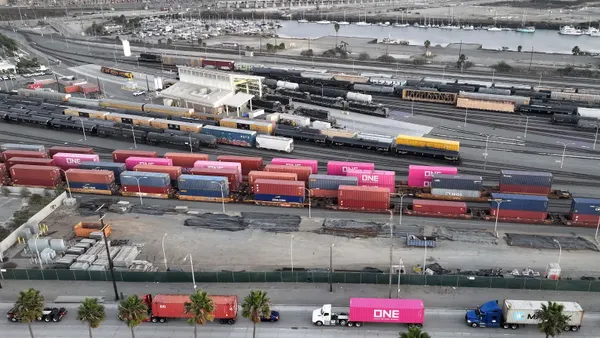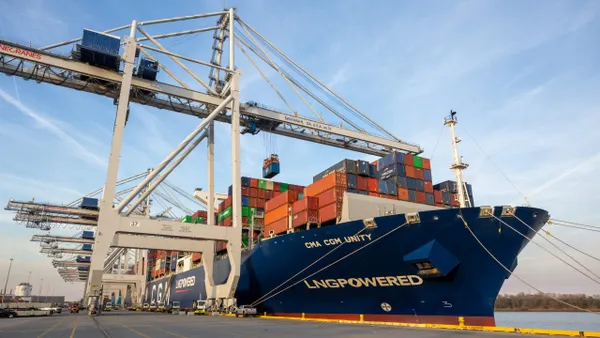Dive Brief:
- Suppliers continued to struggle with deliveries in November as the Institute for Supply Management Supplier Deliveries Index rose to 61.7% for the month, up from 60.5% in October, according to the ISM manufacturing report released Tuesday. Readings above 50 indicate slowing deliveries.
- West Coast port congestion is one factor affecting the movement of goods, according to Timothy R. Fiore, chair of ISM's Manufacturing Business Survey Committee. ISM also noted that suppliers are struggling with staffing facilities as coronavirus cases increase across the globe.
- "We are seeing significant delays in getting parts and material from China through U.S. ports, especially [at the Port of] Long Beach," one survey respondent said, according to the ISM report.
Dive Insight:
Supply chain stakeholders have been voicing concerns about port congestion since early October, as importers have gone through a period of restocking. ISM's report shows that the issues persisted through November. Import levels for ISM's panelist companies continued to show growth in November, but at a slower rate than October.
The month-over-month fall in import growth was "primarily due to port and transportation disruptions for inbound material," Fiore said.
Port congestion is the result of high import volumes. Those levels are expected to continue. Import levels at the Port of Los Angeles are expected to be more than 29% higher this week compared to the same week last year. And the week before Christmas, volume at the port is expected to be up more than 47% YoY.
The disruptions are not just caused by ports trying to funnel large numbers of containers through their gateways, but also by equipment bottlenecks. Shippers need containers to move imports and exports, and container availability in China continues to be at a record low, according to figures provided by Container xChange.
While retailers have been busy stocking up for peak holiday season, manufacturers will tend to stock up around the March to April timeframe, which means there might not be much relief for the port congestion heading into the new year, Fiore said Tuesday on a call with reporters.
"It's all good for the economy," he said. "When you have ports bogged up, it means you got demand. I don't think it's really impacted the inventory numbers."
Despite bottlenecks, the manufacturing industry showed growth in November, though at a slower rate than in October, with the manufacturing PMI reaching 57.5%. Numbers above 50 show an expanding manufacturing sector.
But with coronavirus case numbers surging to a new peak across the U.S., factories and their suppliers have struggled with employment, Fiore said.
"We are getting a lot more COVID-19 hits in our factories," one ISM panelist company in the food and beverage space is quoted as saying in the report. "We are also sending employees home for 14 days to quarantine if they were in close proximity to individuals that tested positive. We have had to shut down production lines due to lack of staffing."
Another panelist in the transportation equipment industry said the surge was affecting its tier 1 and tier 2 suppliers.
"So we're having a steady decline in operating efficiently with no real end in sight," Fiore said, noting that the vaccine will bring relief eventually. "But the general working population, non-high risk, is going to continue to have to fight through this for another seven, eight months."
Lear Corporation CEO Ray Scott mentioned how the virus was affecting suppliers and the supply chain in the company's earnings call at the end of October.
"Absenteeism still seems to be an issue throughout the supply base," Scott said. "I break it up into two issues: Demand very strong, the supply chain very fragile and there’s ... some things that happened recently that are going to put more pressure on that supply chain."
Manufacturers have been trying to deal with this by raising wages and providing special bonuses, Fiore said.
On the wage increases, he said, "I don't think it's enough."













